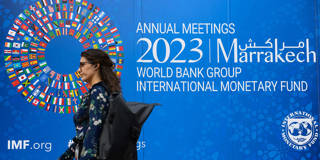A string of high-level meetings this year have produced a number of proposals for dealing with key global challenges, from unsustainable public debt to climate change. But few decisions have been made, and some of the most prominent proposals are deeply flawed.
BOGOTÁ – The global economic agenda has been packed in 2023. There was the United Nations High-Level Political Forum in July, dedicated to monitoring progress toward the Sustainable Development Goals. The second SDG Summit was held in September, as was the G20 summit in New Delhi, followed in October by the annual meetings of the World Bank and the International Monetary Fund in Marrakesh. In November, the UN adopted an important decision on international tax cooperation. Now, leaders are meeting in Dubai for the annual UN Climate Change Conference (COP28).
One obvious lesson from the meetings so far is that the world is taking far too long to achieve the SDGs – especially ending poverty and ensuring food security – and to make meaningful progress in the fight against climate change. Another is that the global economy is confronting policymakers with multiple risks: in 2022, a surge in inflation led to rapid interest-rate hikes in many countries, which, together with soaring public debt, limited governments’ ability to use expansionary fiscal policy to counter slowing growth. Although inflation is coming down, high interest rates and slower growth persist.
Among the measures that have been proposed at and around this year’s meetings, three stand out. First, international development financing must be expanded significantly. Second, developing countries need more support to enable them to contribute to the provision of global public goods, particularly the fight against global pandemics and climate change, and manage the effects of international economic disruptions. Third, some form of relief must be provided to countries at high risk of debt distress – a group that includes at least one-third of developing economies.

BOGOTÁ – The global economic agenda has been packed in 2023. There was the United Nations High-Level Political Forum in July, dedicated to monitoring progress toward the Sustainable Development Goals. The second SDG Summit was held in September, as was the G20 summit in New Delhi, followed in October by the annual meetings of the World Bank and the International Monetary Fund in Marrakesh. In November, the UN adopted an important decision on international tax cooperation. Now, leaders are meeting in Dubai for the annual UN Climate Change Conference (COP28).
One obvious lesson from the meetings so far is that the world is taking far too long to achieve the SDGs – especially ending poverty and ensuring food security – and to make meaningful progress in the fight against climate change. Another is that the global economy is confronting policymakers with multiple risks: in 2022, a surge in inflation led to rapid interest-rate hikes in many countries, which, together with soaring public debt, limited governments’ ability to use expansionary fiscal policy to counter slowing growth. Although inflation is coming down, high interest rates and slower growth persist.
Among the measures that have been proposed at and around this year’s meetings, three stand out. First, international development financing must be expanded significantly. Second, developing countries need more support to enable them to contribute to the provision of global public goods, particularly the fight against global pandemics and climate change, and manage the effects of international economic disruptions. Third, some form of relief must be provided to countries at high risk of debt distress – a group that includes at least one-third of developing economies.